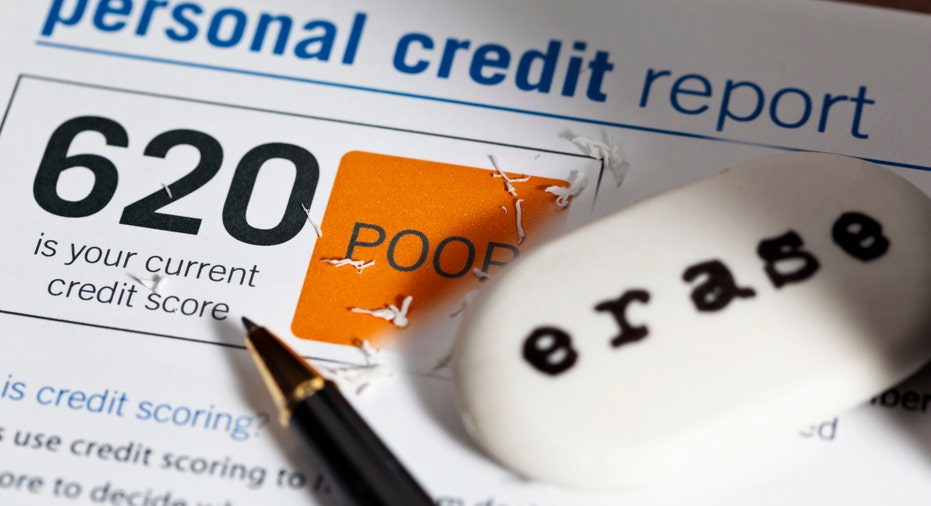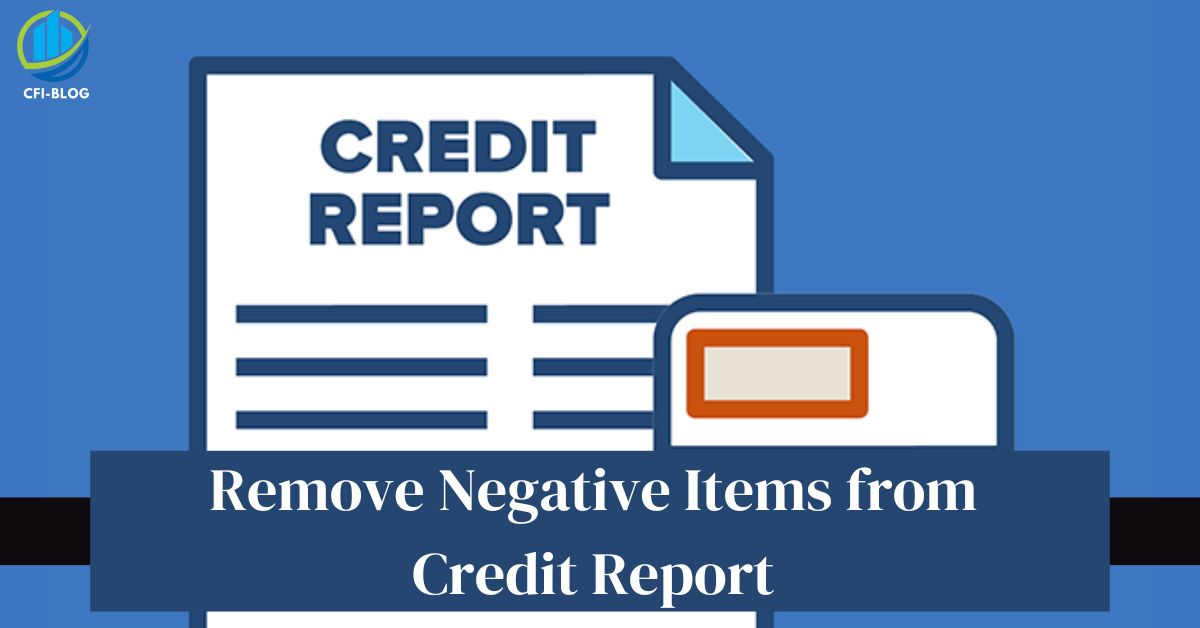Negative information on your credit report indicates that you have made financial mistakes in the past. This may or may not be your fault, as inaccurate information on your credit report may be the result of errors made by credit bureaus. In either case, it is your responsibility to work towards the removal of negative items from your credit report.
You can improve your credit score by removing accurate errors from the credit report. A repaired credit report is also worthwhile to get approval for loans, and credit cards with favorable interest rates. A better credit report is also essential for getting approved for credit cards, loans, and accounts with favorable interest rates. Want to know “How to Remove Negative Items From Credit Report Yourself”? If so, you should scroll down on this page because we have provided the best guidance in the easiest way possible so that you can get the solution along with the facts immediately.
What Data Appears On Your Credit Report?

The items appearing in your credit report can inform you a lot about your financial situation and alert you if you have been suffering from the danger of identity theft. To verify the accuracy of the information, you should get a copy of your credit report every year.
Information about you, your transactions, debts, inquiries, and public records are all included in credit reports. Regardless of the credit agencies, you can often see the following information on your credit reports.
Personal Information
- Your full name.
- Alternate names If you have used to apply for credit in the past, such as nicknames, your surnames prior to marriage, and your name without your middle name.
- Date of birth.
- Address linked with credit accounts, both current and previous.
- Contact numbers used in your account.
- Social Security Number (SSN).
- Employers you have previously worked for and mentioned on credit applications.
Accounts
- Historical (7 to 10 years old) and current credit accounts such as installment and revolving accounts
- Creditor or lender’s name
- Date of opening and closing
- Amount of a loan on credit card on credit card
- Past or current due status
- Account Balances
- History of payments
- Rental leases or utility accounts
Inquiries
- Credit report-pulling companies
- When you accessed your report
Public Records
- Bankruptcies
- Foreclosures
- Liens
- Civil suits and judgments
How to Remove Negative Items From Credit Report Yourself?

First and foremost, knowing your rights regarding your credit history is essential. In accordance with the Fair Credit Reporting Act (FCRA), lenders and credit agencies want to ensure that the details they report are accurate and true. This indicates that you are getting the right to argue against inaccuracy given in your credit report. Additionally, the agencies have the responsibility to erase the errors you dispute if they discover it is not yet updated or not following your records properly.
Payments that are incorrectly registered as delayed or closed accounts that are still recorded as existing are examples of common errors in credit reports. Your report may also contain information from another individual, possibly with an address, social security number (SSN), or other identifying information that is comparable to your own.
Remember that accurate details cannot be erased from your credit report for at least seven years. So, if the right statements have affected your credit score, you will need to work on improving it over time by paying your bills without delay and paying down your entire debt.
Here are some suggestions for “How to Remove Negative Items From Credit Report Yourself”:
1. Get a Copy of Your Credit Report for Free
It is essential to review your credit report routinely in order to identify any wrongdoing or error promptly. You should definitely do it once a year, if not more frequently.
As per federal law, you are entitled to one free annual credit report by all three great credit agencies: Equifax, Experian, and TransUnion. You are able to request on the Annual Credit Report website, which is the only source to provide a free credit report. This site is licensed by federal law.
You should check your reports from all these informed agencies because they may contain different details from lenders and creditors.
You can also request them by mail; to do so, you must first download and print the request form then complete it and send it to the Annual Credit Report Request Service at the end.
Additional Method to Receive Your Credit Report
You can check other copies of your annual credit report for free if:
- You have been turned down for employment, insurance, or credit in the last 2 months because of your low credit score.
- Your insurance range or credit limit has suddenly changed.
- Benefits from the government are going to you.
- Identity theft has claimed your identity.
- You are unemployed.
- You submit an employment application within sixty days of the request’s date.
2. Submit a Complaint to the Credit Reporting Bureau
When you get your credit reports, check all the accounts to see if there are any unknown accounts or creditors. Along with this, it is also very important to check whether derogatory statements— that have been reported for more than 7 years since the initial delinquency date— continue to be reported.
If you do find errors in the reports, contact the reporting agency via its official website or mail to dispute them speedily. The agency will begin an inquiry as a result of this. Remember that you must dispute the items with all three agencies to ensure that deletion is completed on all levels.
3. Examine the Claims’ Outcomes
Disputes are typically investigated within 1 month by reporting bureaus and lenders. When they have decided, they inform you around 5 days after they finish their review. You will be informed through the notice whether the disputed items are false or true.
The bureaus must either remove or update the disputed information if it is true. If there is any change after clearing the dispute items, they should provide you a free-of-charge copy of your credit report file.
You are also able to file another claim if the agency or lender determines that the disputed items are not incorrect. Check your starting claim for wrong information and make any necessary corrections. Check your initial disputed file for errors and make any necessary corrections. If at all possible, you need to add other documents to aid your claim request that can assist the agency to evaluate the data it may not have made the first time.
4. Hire a Credit Repair Firm
Fixing mistakes can take a long time, especially if you have a history of multiple errors or were the sufferer of identity theft. If there are errors in your file, credit repair companies with a good reputation, like Lexington Law, Credit Saint, or Sky Blue, might be a good option to make them correct. You can get assistance from credit repair companies to dispute inaccurate items and negotiate with creditors.
Nevertheless, if you choose to connect with a credit repair company, keep in mind that there are laws for consumer protection that direct what are their rights and responsibilities.
Important Rules & Regulations:
In relation to credit repair services, the following rules and regulations are established by the Credit Repair Organization Act:
- They are required to provide a comprehensive description of their provided services.
- They cannot provide inaccurate or ambiguous information about a person’s identity or credit history.
- It’s crucial to arrange a written contract that specifies the service being provided, the length of time these services will be delivered, and how much they will cost in total.
- They are entitled not to charge any fee for the service until they’re completed in all respects. Despite the fact that the majority of them impose a small fee for initial services.
- They cannot guarantee that false information will be erased from your credit record before the legal deadline (usually seven years for the majority of derogatory entries, and ten years for the bankruptcy filings).
- You can review the agreement and cancel too. If you do this within three days, then no penalty will be imposed on you.
Before you interact with any company, you should be aware of the ways in which they are able and unable to assist you. For instance, any business that claims to establish a new credit profile for you or claims to erase the negative information (that is accurate) from your credit report is most likely connected to a scam or illegal activity.
How to Remove Negative Items From Credit Report before 7 years?

Removing items from credit reports prior to seven years can only be done if the reporting bureaus made a mistake. There are wonderful solutions that actually work to delete these items after some days because the verification process takes time after carefully reviewing your financial records. There is absolutely no chance that you will be able to correct your actual financial bad statements before 7 years pass.
How to Remove Disputes from Credit Reports?
Clearing credit reports by removing accurate information cannot be possible until the legal terms imposed by law expire, which for the majority of wrong items is seven years. We understand you by an example, If you actually miss your credit card payments, your dispute will be rejected to remove that statement.
However, after seven years have passed since you missed a payment, the information will be erased from your credit report automatically. If there is accurate negative information on your records, the following guidelines can assist you a lot:
1. Make a Goodwill Removal Request
People who have established a good reputation with their creditors find that sending a goodwill deletion letter is an option that they can consider. If you have paid off all of your previous overall debts in a timely manner and have been paying your bills on time each month or year, your creditor may be ready to give you a late payment waiver.
This tactic does produce results for some, despite the fact that there is no assurance that the creditor will remove the derogatory items from your credit report. Letters of goodwill are most effective for one-time issues like a missed payment. Nevertheless, debtors who have a track record of defaults, late payments, or collections will not benefit from them.
How to Write a Goodwill Deletion Letter
If you want to know how to remove a derogatory item from a credit report, try the methods listed below:
- Take accountability for the problem that resulted in the derogatory sign.
- Give a proper explanation of why you failed to pay.
- Prior to the incident, highlight a positive payment history if it is possible.
2. Get Help from a Credit Counseling Company
The National Foundation for Credit Counseling and other non-profit credit counseling organizations can assist you in disputing inaccurate information on your record. Here, NFCC will guide you on how to organize your budget, free advice on financial planning, and how review your credit history and enroll you in a debt management program without any charges.
Additionally, it provides assistance with bankruptcy, homeownership, and avoiding foreclosure. Always be on the lookout for agencies that over-deliver, and claim to be the best, and require payment even before providing the entire service.
- The Attorney General of your State
- Companies that protect consumers locally
- United States Trustee Program
3. Apply a Negotiation Strategy— Pay for Delete
You must try and carry out a negotiation method that is referred to as “Pay for Delete, right here you need to pay off your debt (completely or partly) then the creditor can be equipped to erase the derogatory records from your file. This system is meant to eliminate negative records that are rightly reported, which include missed payments on credit cards or loans.
In short, you will send a pay-for-delete letter to the creditor or collection company informing them that you are ready to repay the debt as long as the facts are retracted from your report.
Generally, this method is unlikely to work— collection companies are not obligated to react to your request if the derogatory item is accurate. If they decide to do so, they could give a written response that confirms they will take back the item, and outline their selected payment approach.
Will “Pay for Delete” Repair Your Credit Score?
Paying off the debt might be quite an incentive for collection agencies to remove negative items on credit reports because they want to recover all their possible money. Pay for delete, on the other hand, is an indeterminate program and not a reliable option. Like creditors and reporting agencies, collection companies are required to report valid information.
While you are free to request, A collection agency can deny or accept your appeal. If you actually paid for the collection, they may be ready to admit to marking it as paid, but they will not remove the collection item itself.
Additionally, keep in mind that agreements that pay-for-delete might not help your score to build. The accounts of the paid collection are not allowed in the calculation of your credit score by the latest models such as 4 of VantageScore and 9 of FICO. This indicates that the negotiation of this request will result in the same outcome as the full payment of the account. However, remember that collections that aren’t paid off will keep lowering your score.
Can I Remove Disputes from the Credit Report Overnight?
If you want to know “How to remove negative items from a credit card overnight? No tips have been made about this because it is not possible that they can be corrected overnight. The process of erasing bad credit takes a lot of time and sometimes it consumes months too. You must get in touch with lenders and credit agencies to raise your objection to the incorrect statements mentioned in that, and they can respond within a month.
To validate this whole scenario, they might also want more evidence, which will prolong the procedure. Also, keep in mind that the right negative details cannot be removed from your credit record and will be present there for a minimum of 7 years.
Common Errors People Find On Their Credit History
The Consumer Financial Protection Bureau says that these are the most frequent errors made by consumers and then they get on their credit records.
Mistakes with Identical Details
- Incorrect name
- Address
- Contact number
- Accounts with the same name
- Your identity was used to open a credit account.
Wrong Status of Your Account
- Accounts that were marked incorrectly as open, past due, or in default.
- Accounts mistakenly recorded you as an authorized user rather than the owner.
- Incorrect details of account’s opening date, delinquency report, or last received payment.
- Multiple listings of the same debt.
Management of Data
- Information that has already been contested and corrected but is not removed.
- Multiple accounts are listed with various creditors.
Balance Status
- Wrong ongoing balance
- Wrong Credit Limit
Factors That Affect Your Credit Score
One by One Hard Inquiry
If your credit history is subjected to several hard credit checks in a short period of time, your credit score will significantly drop. Because it indicates that you have applied for credit numerous times but have been turned down for approval.
There are, however, a few exceptions to this, for instance, you can compare rates from various lenders if you want to buy a house.
Delinquency
When determining a credit score, payment history may be the most significant factor. Your score will suffer greatly if you pay late so frequently or do not pay at all. Your credit score will not be negatively impacted if you are unable to pay within a few days of the due date because your creditors do not immediately inform the reporting companies. However, if you are more than 30 days late, it will most likely be recorded on your credit report.
Foreclosure
A credit score can also significantly drop after a foreclosure. As per FICO, a foreclosure can cause a score drop of up to one hundred points, based on the initial score of the consumer. The status of foreclosure remains on your credit report for seven years.
Charge-offs
When the creditor has lost all hope that the consumer will repay the debt, a charge-off occurs, which means that there is no possibility left to get money back from the consumer’s side. In that case, the charge off on your credit report shows. Even though there is also a charge of debt off within 3 months by some creditors, this may occur if the debt is not paid off within 6 months. Charge debt offs can lower your credit score by as much as 100 points.
Repossessions
If you consistently miss payments on your loan, the creditor can repossess your assets and have a negative impact on your credit scores— up to 100 points drop.
Judgments
If a debtor or debt collection company files a lawsuit against you, a judgment could be rendered by a court. Like this, you will be required to pay your debt as well as attorney and other costs and fees. A judgment can have varying effects, but it could result in a 100-point drop in your score.
Collections
When the actual creditor collaborates with an outside company to recover stopped payment, this is called a collection. This information is reflected in your credit payment records and can reduce your score by more than one hundred points.
Bankruptcy
A bankruptcy filing can lower your score by as much as 200 points. It will also make it harder for you to get new loans or credit lines for many years and it will continue until your credit history improves.
What Effect Do Errors Have on Your Credit Score?

FICO and VantageScore are the credit scoring models that are extensively used to calculate credit scores. Criteria and metrics are approached differently by each model. However, each uses records from great credit reporting bureaus to determine your score.
When calculating your credit score, the same aspects are covered by both models. Examples of these are the total amount of credit you’ve used and how long your credit history is. However, the most crucial aspect of your credit score is the paying-off history.
Approximately 42% of VantageScore and 35% of FICO scores are based solely on your payment history. One single wrong delay payment could have a significant impact on your credit score due to the importance of your payment history. As per FICO, if you have 3 months of missed payment on your report, it could hurt your score by up to 180 points.
How to Remove Negative Items From Credit Reports in Case of Identity Theft?
If you have been suffering from identity theft, first of all, you should initiate a dispute with the FTC (Federal Trade Commission) by visiting the website of identity theft. You can also take the support of the police by telling them the whole scenario.
You must follow the following steps after filing the report:
- Through AnuualCreditReport.com you can ask for a copy of your credit report.
- Close your compromised accounts by contacting the lender.
- To dispute any credit information that is irrelevant to you, connect to the credit bureaus.
- Secure your credit report through a security freeze and fraud alert.
- Keep an eye out for any new accounts or unsanctioned transactions.
- It is suggested to avail of any credit monitoring or identity theft protection service.
How Identity Theft Hurts Your Credit Report?
When your personal details are stolen and someone else is using them to create a financial account, it can harm your credit. If the identity thief applied for multiple new accounts in a frequent manner, these accounts will present on your credit report and degrade your score.
After an identity theft, it can take months and years to fix the damage to your credit. The later you feel that your identity has been stolen the more complicated it will become to wipe out the damage.
It is very important to learn How to Remove Negative Items From Credit Report Yourself by avoiding Identity Theft and monitoring your report to protect your personal information.
Frequently Asked Questions (FAQs)
Q.1 Can I get items removed from my credit report?
To remove credit report items, you must be aware that only the negative information that is inaccurate can be deleted from there. If the statements match your previous financial records, you will not be able to remove them from your credit report. You cannot delete accurate negative items at all as they cannot be removed from your credit report before seven years.
Q.2 Can something be removed from the credit report and added back?
Yes, it can also be possible in some cases. There are a few reasons why a deleted item may reappear on your credit reports. For instance, If the furnisher does not respond at all to a dispute credit report, the credit agencies would erase the clean credit report item. Hoover, the information could be added back if the furnisher reports it again to the credit reporting companies the next month in the form of their usual credit reporting updates.
Q.3 How do I get something removed from my credit report before 7 Years?
You should get a copy of your credit report through reporting agencies and look for inaccurate information, such as accounts that are not yours or missed payments. If there is any inaccuracy, submit a dispute right away through postal mail or online with the credit agencies. You can also attempt to make goodwill delete requests. Be aware! You should look for “How to remove negative items from credit report yourself” as soon as possible because the more you delay, the more difficult it becomes to get rid of the error report.
Conclusion
The only information used to determine your credit score comes from your credit report. When making decisions about you, a variety of creditors/ lenders examine your credit report. Your slight financial mistake can add negativity about you to the credit card and that remains intact for years. However, the mistakes might not always be yours because the inaccurate information may also be from the side of the credit agencies. If you find yourself in a situation like this, you need to get started checking How to Remove Negative Items From Credit Report Before 7 Years because the longer you wait, the harder it will be to get rid of them. Unfavorable entries on your credit report can be removed in a few different ways that we have discussed on this page.
Author Profile
- Elizabeth Jones is one of our editorial team’s leading authors on credit card offers, services & more. With over two decades of experience in the consumer credit industry and as a nationally recognized credit expert, Elizabeth provides in-depth analysis of both traditional & alternative forms of credit. Elizabeth regularly appears on many major media outlets including NBC Nightly News, Fox Business Network, CNBC & Yahoo! Finance. She is also a frequent contributor to Forbes Magazine. As a highly appreciated author for our exclusive Editorial Team, Elizabeth strives to provide readers with a trustworthy advice on how to manage their credit accounts while staying informed on the latest offers in the marketplace.
Latest entries
 BlogJuly 8, 2024Why is Your Cash App Not Working? Solutions Revealed!
BlogJuly 8, 2024Why is Your Cash App Not Working? Solutions Revealed! BlogSeptember 26, 2023How to Block Payments on Cash App: A Comprehensive Guide
BlogSeptember 26, 2023How to Block Payments on Cash App: A Comprehensive Guide BlogSeptember 21, 2023How to Add Money to Apple Pay: A Comprehensive Guide
BlogSeptember 21, 2023How to Add Money to Apple Pay: A Comprehensive Guide BlogSeptember 20, 2023PayPal Gift Cards: Everything You Need to Know
BlogSeptember 20, 2023PayPal Gift Cards: Everything You Need to Know

